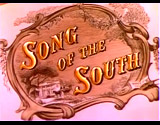
|
Song of the South (1946)
In Disney's remarkable film (a hybrid of
live action and animation) that has since been accused
of racial stereotypes - based on
the "Uncle Remus" stories
in the late 1800s of Joel Chandler Harris (first published as columns
in the Atlanta Constitution newspaper), and presented
as one of their earliest, innovative live-action (70%) and animation
(30%) mixtures - it was Disney's first attempt to make a feature
film that included extensive, dramatic live-action footage:
- set presumably after the Civil War in the mid-to-late
1800s at a time when slavery was abolished during the Reconstruction
Era in Georgia, it told about a family that journeyed from their
home in Atlanta to a large rural plantation (owned by Sally's
(Ruth Warwick) mother Miss Doshy (Lucile Watson))
- they rode in an open carriage together. Sally and her husband
John (Erik Wolf) were in the midst of a marital separation,
and young 8 year-old son Johnny (Bobby Driscoll) was being taken
by his mother to live with his grandmother for an extended period
of time, while his newspaper-editor father John returned to
Atlanta without them; Johnny was cared for by black nursemaid Aunt
Tempy (Hattie McDaniel)

|
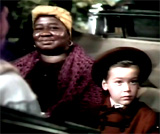
|
|
Sally and John
|
Aunt Tempy and Johnny
|
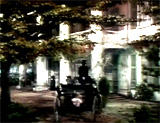
|
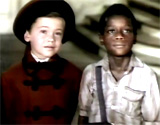
|
|
The Plantation House
|
Servant boy Toby (Glen
Leedy) with Johnny
|

|
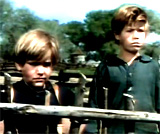
|
|
Ginny Favers (Luana
Patten) with Dog Teenchie
|
Joe and Jake Favers - Ginny's Two Bullying Brothers
|
- once his father departed back to Atlanta and the
distressed young Johnny feared the threatened divorce of his
parents, he decided to run back to the city; he
was befriended and comforted by the charismatic handyman and folk story-teller
(and former slave) Uncle Remus (Special Oscar-winning James Baskett),
who took him to his cabin for some
"grub" (cornbread and sweet taters) and became his best
friend and confidante
- storytelling Uncle Remus
illustrated life lessons to help Johnny deal with his family and
personal troubles through three animated sequences that featured
Uncle Remus characters (i.e., Br'er Rabbit, wily Br'er Fox, and
the stupidly dim-witted Br'er Bear). Br'er Rabbit was able to outtrick
the fox and bear in all three instances of his tales:
"Br'er Rabbit Earns a Dollar a Minute" (approx.
8 minutes), featuring the Oscar-winning song: "Zip-a-Dee-Doo-Dah"
While running away from his briar patch ("I
ain't ever comin' back"), Br'er Rabbit became caught
in Br'er Fox's snare trap, at the edge of a cornfield; he
fooled Br'er Bear into switching places with him as a 'paid'
scarecrow (for a dollar a minute) to protect the field; Br'er
Rabbit learned his lesson about leaving home (and so did
Johnny) - "You can't run away from trouble."

|
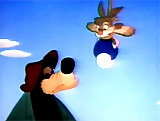
|
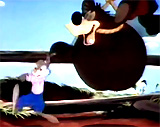
|
|
"Br'er Rabbit Earns a Dollar a Minute"
|
"Br'er Rabbit and the Tar Baby" (approx.
12 minutes), featuring the song: "How Do You Do?"
After Br'er
Rabbit's arm (and entire body) became stuck in Br'er Fox's trap on
the side of the road - a 'tar-baby' (a doll-like clothed figure composed
of sticky tar), he begged them to be released, using reverse psychology
- do anything you want with me – roas' me, hang me, skin me,
drown me – "but
please, Br'er Fox, don't fling me in dat brier-patch" -
and the gullible Fox complied, thereby freeing Br'er Rabbit.
The lesson taught to Johnny was that people shouldn't get involved
with something they have no business with in the first place.

|
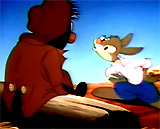
|

|
|
"Br'er Rabbit and the Tar Baby"
|
"Br'er Rabbit's Laughing Place" (approx.
5 minutes), featuring the song: "Everybody's Got a Laughing
Place"
Br'er Rabbit was again captured by the Bear and Fox
(and was about to be BBQ'd on a fire for dinner), but convinced his
captors to lead him to his secret "laughing place" (he
tricked them by taking them to a bee hive in a bushy thicket) and
was able to escape. The story helped Johnny and Ginny to be cheered
up after the Favers boys bullied them, and they were unable to attend
Johnny's birthday party.

|
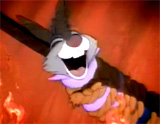
|
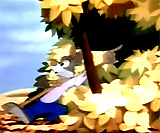
|
|
"Br'er Rabbit's Laughing Place"
|
- rather than his own peers,
Johnny preferred to spend time with his black servant Toby, playing
with a croaking frog. He also suffered the bullying of two poor
'white-trash' boys, Joe (Gene Holland) and Jake Favers (Georgie
Nokes), who threatened their blonde sister Ginny's runt dog named
Teenchie, that was given to Johnny as a gift. As a result of
Uncle Remus' second tale, Johnny used reverse psychology on the
Favers boys, daring them to not tell their mother about the dog,
but of course they did - and they received a whipping from their
mother. However, Sally ordered Uncle Remus to stop telling tall
tales to the impressionable Johnny, and Teenchie was reluctantly
returned to the Favers.
- in the film's conclusion,
when storyteller Uncle Remus was leaving the plantation and departing
for Atlanta, the young boy was dismayed and felt deserted. He
took a shortcut across a pasture to try and catch up to him.
He was seriously injured by a bull, but was revived from death
by the return of his father to the plantation and story-telling
Uncle Remus who reprised the "Laughing
Place"
tale. Johnny reached out for Uncle Remus' hand for comfort, and was
assured by his father and mother that the family was back together
for good ("We'll have the laughing-est place in the whole wide
world")
- the film ended with the
cartoon characters (butterflies, Br'er Rabbit, a frog and more)
interacting with Uncle Remus and the children (Johnny, Ginny,
and Toby) as they skipped along the road toward the horizon while
singing "Zip-A-Dee-Doo-Dah."
|

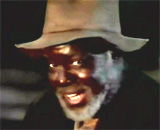
First Views of Storyteller Uncle Remus

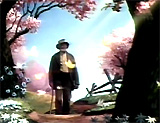

"Zip-a-Dee-Doo-Dah"
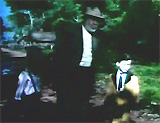
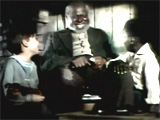
Storyteller Uncle Remus with Johnny and Toby
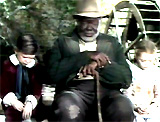
Storyteller Uncle Remus with Johnny and Ginny
The Remus Tales:

Br'er Rabbit

Br'er Fox and Br'er Bear
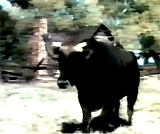

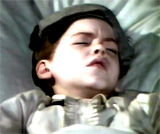
Bull Attack on Johnny
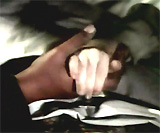

Revived from Death by Uncle Remus
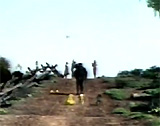
Ending Image
|

















